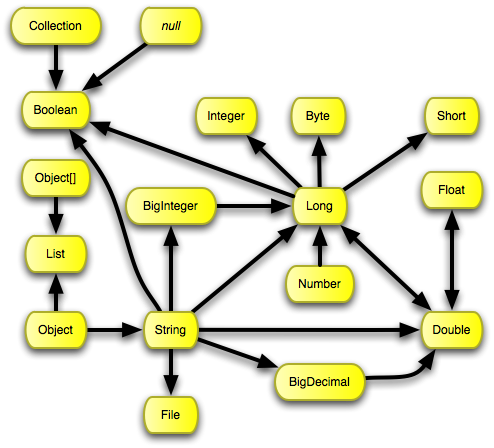转自:http://tapestry.apache.org/typecoercer-service.html
Type Coercion
Type Coercion is the conversion of one type of object to a new object of a different type with similar content. Tapestry frequently must coerce objects from one type to another. A common example is the coercion of a string into an integer or a double.
Although type coercions happen more inside tapestry-core (including coercions ofcomponent parameters), they may also happen inside tapestry-ioc, such as when injecting a value, rather than a service, into a builder method.
Like everything else in Tapestry, type coercions are extensible. At the root is theTypeCoercer service. Its configuration consists of a number of CoercionTuples. Each tuple defines how to coerce from one type to another. The initial set of coercions is focused primarily on coercions between different numeric types:

Default Type Coercions
There are a few special coercions related to null there; Object -->List wraps a lone object as a singleton list, we then neednull -->List to ensure that null stays null (rather than a singleton list whose lone element is anull).
Tapestry can interpolate necessary coercions. For example, say it is necessary to coerce aStringBuffer to anInteger; the TypeCoercer service will chain together a series of coercions:
- Object --> String
- String --> Long
- Long --> Integer
Coercing from null
Coercing from null is special; it is not a spanning search as with the other types. Either there is a specific coercion fromnull to the desired type, or no coercion takes places (and the coerced value isnull).
The only built-in null coercion is from null to boolean (which is always false).
List of Coercions
As of Tapestry versions 5.1 and 5.2, the following coercions are available:
Double --> Float Float --> Double Long --> Boolean Long --> Byte Long --> Double Long --> Integer Long --> Short Number --> Long Object --> Object[] Object --> String Object --> java.util.List Object[] --> java.util.List String --> Boolean String --> Double String --> Long String --> java.io.File String --> java.math.BigDecimal String --> java.math.BigInteger String --> java.text.DateFormat String --> java.util.regex.Pattern String --> org.apache.tapestry5.Renderable String --> org.apache.tapestry5.SelectModel String --> org.apache.tapestry5.corelib.ClientValidation String --> org.apache.tapestry5.corelib.LoopFormState String --> org.apache.tapestry5.corelib.SubmitMode String --> org.apache.tapestry5.corelib.data.BlankOption String --> org.apache.tapestry5.corelib.data.GridPagerPosition String --> org.apache.tapestry5.corelib.data.InsertPosition String --> org.apache.tapestry5.ioc.Resource String --> org.apache.tapestry5.ioc.util.TimeInterval boolean[] --> java.util.List byte[] --> java.util.List char[] --> java.util.List double[] --> java.util.List float[] --> java.util.List int[] --> java.util.List java.math.BigDecimal --> Double java.util.Collection --> Boolean java.util.Collection --> Object[] java.util.Collection --> org.apache.tapestry5.grid.GridDataSource java.util.Date --> java.util.Calendar java.util.List --> org.apache.tapestry5.SelectModel java.util.Map --> org.apache.tapestry5.SelectModel long[] --> java.util.List null --> Boolean null --> org.apache.tapestry5.grid.GridDataSource org.apache.tapestry5.ComponentResources --> org.apache.tapestry5.PropertyOverrides org.apache.tapestry5.PrimaryKeyEncoder --> org.apache.tapestry5.ValueEncoder org.apache.tapestry5.Renderable --> org.apache.tapestry5.Block org.apache.tapestry5.Renderable --> org.apache.tapestry5.runtime.RenderCommand org.apache.tapestry5.ioc.util.TimeInterval --> Long org.apache.tapestry5.runtime.ComponentResourcesAware --> org.apache.tapestry5.ComponentResources short[] --> java.util.List
Contributing New Coercions
TypeCoercer is extensible; you may add new coercions as desired. For example, let's say you have aMoney type that represents an amount of some currency, and you want to be able to convert fromBigDecimal toMoney. Further, let's assume that Money has a constructor that accepts aBigDecimal as its parameter. We'll use a little Tapestry IOC configuration jujitsu to inform the TypeCoercer about this coercion.
public static void contributeTypeCoercer(Configuration<CoercionTuple> configuration) { Coercion<BigDecimal, Money> coercion = new Coercion<BigDecimal, Money>() { public Money coerce(BigDecimal input) { return new Money(input); } }; configuration.add(new CoercionTuple<BigDecimal, Money>(BigDecimal.class, Money.class, coercion)); }
Further, since TypeCoercer knows how to convert Double to BigDecimal, or evenInteger (toLong to Double) to BigDecimal, all of those coercions would work as well.
When creating a coercion from null, use Void.class as the source type. For example, the built-in coercion fromnull toBoolean is implemented as:
configuration.add(new CoercionTuple(void.class, Boolean.class, new Coercion<Void, Boolean>() { public Boolean coerce(Void input) { return false; } }));